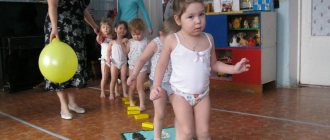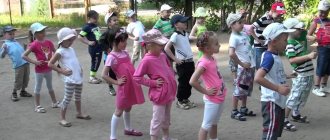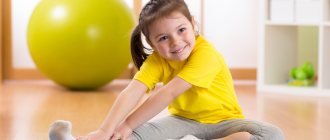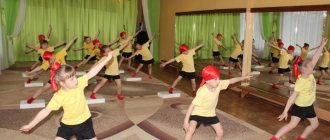Individual approach
You can organize morning exercises for children in different ways. A little desire and imagination - and parents develop their own complex, which is not taught in kindergarten or school. This approach should be built taking into account the interests of the boy or girl, their capabilities and characteristics.
As the preschooler grows, the time of classes and their dynamism increases. It's time for sons to be given strength exercises, but girls can spend more time stretching. Warm-up slowly turns into more complete activities, which can later turn the child to sports.
In some exercises, children will need direct help from adults or their direct participation:
- Abs pumping. At first, you need to hold the child’s legs or find suitable support.
- Full push-ups from the floor.
- Somersaults forward and backward.
- Headstand and handstand against the wall and then on the mat.
- Working with a spring expander with your hands and feet.
- Squats with different positions of the legs: together, shoulder-width apart, widely spaced.
- Throwing your legs behind your head in a lying position.
- Boxing for boys and tiptoe dancing for girls (although both can be used regardless of the gender of the child).
- Rolling from head to pelvis and back with bent knees (hands behind head).
- Leg twist with bent knees (standing).
- Single and double bicycle in a prone position, alternate and joint leg raises.
- Bent-overs with dumbbells. Instead of store-bought shells, you can use plastic drink bottles filled with water.
All strength exercises should be done 12 to 16 times. If necessary, they can be divided into several approaches. Finally, take a cool shower or douche.
Exercises for children Sunny.mpg
Eastern ornament
New approaches imply the inclusion in regular complexes of not only breathing practices, but also elements of yoga, wushu, and some other oriental martial and health techniques. At first, advanced instructors are not needed here, because initially these directions were created by ordinary people for everyday use.
To organize a more interesting and useful process at home, you should try :
- Place your hands behind your back, secure a stick under your elbows (a regular mop will do). Without releasing the stick, walk, squat, bend, and make smooth turns of the body.
- Bend your arms, raising them so that your clenched fists are at chest level with the inside facing up. Throw them forward sharply. Bring it back so that the knuckles are up.
- Bend your fingers. Raise your palms to eye level with the inside facing your face. Raise your leg bent at the knee. Hold the position for a few seconds. Lower your leg. Make scratching movements with your palms from top to bottom.
- Spread your legs and bend them slightly. Straighten one arm parallel to the floor. Place the second one behind your head in a half-bent position. Step out, half crouching, to the side and at the same time move your arm forward from behind your head. Do the same in the other direction, changing hands.
- Place your right hand on your left shoulder with a half-turn of your torso - inhale, back - exhale. Change shoulder and arm.
- As you inhale, reach the calf muscle as low as possible, straighten as you exhale. When you feel comfortable with the limbs of the same name (right and left), do the same movements crosswise.
Proper breathing against the backdrop of movements that develop the body brings double benefits. Over time, such a complex can successfully replace more dynamic exercises.
Video: Fun exercises for a child
Remember that it is impossible to force a child to exercise like hard labor. It is important that he himself wants to work with you. Therefore, first of all, we demonstrate the importance of charging with our own example.
Children at this age are already excellent at thinking and analyzing, and if you are constantly lying on the sofa, growing a belly, then you simply will not be able to force your child to study - personal example is more effective than all other methods.
The site Colady.ru thanks you for your attention to the article - we hope that it was useful to you. Please share your feedback and tips with our readers!
What mistakes do parents make when doing exercises for their kids?
Infant gymnastics is a very simple activity, however, even in it there are certain rules that must be followed:
- If you see that the exercise is clearly not going according to plan, it means the child is not yet ready for it. Try again in a few days.
- Do not do gymnastics if the baby has just eaten or wants to sleep. All exercises should be done only when the baby is ready for physical activity.
- Watch the signals he gives. If the child is capricious and does not want to exercise, end the training.
- Some parents consider walkers the best exercise for their legs. This is not true - this device is rather harmful to the baby. In a walker, he is in a semi-suspended state, which does not contribute to the development of correct walking skills.
And the most important advice: before introducing each new exercise into the “training program” and with any questions that arise, consult your pediatrician!
Choosing the type of children's gymnastics
Health is unthinkable without movement. And if it is sometimes difficult for us to persuade ourselves to do exercises once again, then children are happy to do it themselves. Once a child starts walking, there is no stopping him. The baby continuously explores the world around him through sight, hearing, taste, smell and touch.
In the first months of life, the child is limited in movement and cognition. But the more varied the movements, the more varied the information obtained through them. So the mental development of a child directly depends on his physical activity.
The dependence here is very simple: a) sedentary muscles, bones, ligaments and joints do not receive enough stimulation, as a result of which b) they do not acquire the tone necessary for further growth, which c) slows down the development of motor skills and abilities, and this leads to d) limitation of capabilities learn new things about the world.
Fortunately, we have gymnastics - it will help eliminate the baby’s lack of movement and create favorable conditions for his health and development. Gymnastics will also help maintain emotional contact between mother and baby. Mom's loving hands, her gentle strokes, her gentle voice when she reads nursery rhymes to the baby during classes - all this makes the baby very happy.
Infants can only participate in passive exercise programs. This:
1) gymnastics (physical exercises);
2) gymnastics on the ball;
3) aqua gymnastics.
You can read about massage, which is also considered a type of passive gymnastics, at this link. And here we will talk about why each of the listed types of gymnastics is interesting and useful.
Gymnastics is good for a wide variety of movements. Exercise improves appetite, digestion, sleep, deepens breathing (thereby developing the lungs), causes increased blood flow to the muscles, to the bones with which they are connected, which promotes their growth. They tone the body and give the baby a great boost of energy and joy. The baby learns to feel his body, understand its signals and be in harmony with his physical self.
Up to a year, it is advisable to precede gymnastics with your baby with a massage session. It warms up and prepares the muscles for stress during physical exercise, which will be the final stage of the massage.
Warm-up
Warming up helps warm up the muscles and avoid subsequent pain. It is important to follow the correct order so that the load does not damage the children’s muscles and ligaments:
- start with fast walking;
- then load the arms, belt, back;
- the next part is strengthening the leg muscles;
- the active part includes running and jumping;
- finish with exercises to calm breathing: walking, inhaling and exhaling while raising your arms, etc.
Other types of children's gymnastics
So you have become acquainted with the most reliable and proven methods. However, there are several other types of gymnastics that parents may be familiar with: baby yoga, dynamic gymnastics and mom yoga.
In the first case, we are talking about the manual practice of getting rid of possible birth injuries in the first two weeks after the birth of a child, which is carried out only by a highly qualified specialist. The second is a set of acrobatic exercises aimed at correcting muscle tone and developing coordination and the vestibular apparatus; training takes place in special classes with an instructor. In the third case, we are talking about mother’s yoga classes in the presence of the baby with a small number of asanas, in which the baby can participate without experiencing any physical activity, but simply maintaining contact with the mother.
Thus, all these types of gymnastics cannot be done at home without preparation. If you are interested in these types of physical activity and are determined to try them, first consult with a pediatrician, neurologist and orthopedic surgeon, weigh the pros and cons, and take training from a certified instructor.
How to prepare a child for exercise?
Of course, it’s difficult to get a child out of bed ahead of time, especially “for some kind of exercise.” This wonderful habit must be instilled gradually.
As you know, for a habit to become established, it takes about 15-30 days of regularly repeated actions. That is, after 2-3 weeks of such activities, your child will already be drawn to them.
Without attitude - nowhere. Therefore, the most important thing in forming this habit is to tune in and find motivation.
In addition, it is important that the child’s exercises change periodically (children at this age get tired of the same type of training too quickly).
And don’t forget to praise your child and encourage any physical activity in every possible way.
Gymnastics on the ball
Children of any age really enjoy exercises on the ball. But in infancy, in addition to the pleasure of activities, we can safely talk about their undoubted benefits.
- Reduce muscle hypertonicity;
- Improve the functioning of internal organs;
- Train the vestibular apparatus;
- Strengthens the muscles of the back, abdomen and limbs;
- Reduce discomfort during colic.
A set of exercises for children helps strengthen the back muscles, especially around the spine, making the spine strong and flexible. And this is the key to the normal functioning of the nervous system and the free distribution of nerve impulses throughout the body.
Basic principles of ball gymnastics
- Strengthening the back muscles - place the child on his stomach.
- Strengthening the abdominal muscles - place the child on his back.
- Strengthening muscles during an umbilical hernia - we place the child on his back.
- General relaxation of the child - usually on the stomach.
- Correction of muscles in case of asymmetry of muscle tone - tilting the ball in the direction where increased tone is observed.
The optimal diameter of the ball for practicing with an infant is 60–65 cm. In infants, in order to reduce increased tone, the ball is lowered slightly; in order, on the contrary, to tone the body, they inflate it tightly. Apart from those common to all types of gymnastics, there are practically no specific contraindications for exercising on a ball, with the exception of an unhealed umbilical wound. You can start classes as early as one month of age.
Don’t worry if at first both you and your baby feel a little unsure and tense: you both will quickly get used to it if you practice regularly and without forcing things.
You will be surprised how quickly your baby’s body will react to such activities: the results of exercises on the ball will be noticeable almost immediately. The baby will become more active, stronger, will no longer be afraid of changes in the position of his body, his sleep and appetite will improve, and he will receive a positive emotional charge.
The principle of an easy start
For children, morning exercises should become an indispensable attribute of the beginning of the day, as familiar as washing and brushing their teeth. Helping the body wake up and saturate its cells with oxygen means creating a good mood for several hours in advance. You need to do the exercises on an empty stomach (this is a requirement not only of Eastern, but also Western methods).
Pediatricians believe that a child can be taught physical education from the age of two. Of course, morning exercises for kids should be as simple as possible, without heavy loads. Otherwise, the child will quickly become disillusioned with the idea, and it is very difficult to convince him otherwise.
For the youngest children, normal, natural movements are suitable.:
- Walking in place for up to 1 minute. Alternately - with a straight foot, on the heels, on the toes, on the outer and inner side of the foot.
- From 4 to 8 tilts forward, backward, right and left. The same number of actions is used in other exercises.
- Squats. You need to keep your back straight, this is useful for developing correct posture.
- Jumping from a standing position.
- Circular movements with your hands: right, left, and then both.
- Raise your legs until they connect with your palms (left to right and vice versa).
- Wall push-ups.
- Place your elbows on the floor with your legs apart in a sitting position.
- Head tilts to each side.
- Slowly march in place with your knees high.
- Raising your arms up as you inhale, lowering them down with a slight tilt as you exhale. These are the first elements of breathing exercises.
The complex ends with water procedures. At first, it will be enough to simply wash your face with warm water. It is recommended to gradually reduce the temperature. It will also be useful for the child to have a short massage.
Morning exercises for children 1-3 years old [Loving mothers]
Preparing for kindergarten
The simplest morning warm-up for children is one of the steps to prepare kids for kindergarten. Even a minimal habit of physical activity will be beneficial; the child will not feel like a black sheep in the team. At 3-3.5 years old, the home complex can be complicated.
To the already known exercises should be added:
- Jump on each leg alternately. Now the exercises are done at least 8, but no more than 12 times, unless they are performed for a while.
- Jumping from a sitting position with arms thrown up.
- Push-ups from a cabinet or floor.
- Run in place or in a circle.
- Tilts touching the floor with the fingertips of both hands, as well as one and the other, opposite legs.
- Bend forward to closed legs, and then to spread legs in a sitting position.
- With good stretching - splits. If it doesn’t work out completely, you can start with a partial one.
- Jumping rope.
- Spinning a hoop (this is also useful for boys).
- Rotation of the upper body in one direction and the other (clockwise and vice versa).
- Stepping onto a stand or bench.
- In the finale, raising your arms and inhaling, step forward, while exhaling and lowering your arms, return to your normal position.
In the garden, as a rule, physical education is accompanied by music. To better prepare your baby, you also need to include support at home. The melodies can be different, but they should be characterized by enthusiasm, active rhythm, and not put the child to sleep.
Morning exercises for children improve coordination, promote motor development, and strengthen muscles. It also helps in preventing excess weight. After just the first 2-3 sessions, you will notice an undeniable effect.
Gardeners complex of morning exercises for children of the younger group









